Please note – the insights provided are based on data provided by product marketers who participated in our annual salary survey report.
Are you a product marketer wondering how your salary stacks up? Or perhaps you're considering a career in this area and are curious about what you could earn. Navigating the financial expectations of a product marketing manager in the United States can be a complex task.
Product marketing is an elite field, but compensation remains an elusive topic. In a landscape where demand for experts is surging, it begs the question: Does your compensation align with the substantial skills and efforts you contribute?
Let's cut through the fluff and dive into the real numbers.
US salary average
As a PMM (product marketing manager), your earnings are shaped by an array of elements. This blend dictates what a PMM in today's vibrant market can command in terms of compensation.
The financial picture for product marketers across the US is telling. The average total compensation, encompassing salary, bonuses, and stock, comes to a substantial $162,649 per year.
Digging into these numbers, we find an average base salary of $144,369, enriched by an average bonus of $13,341 and stock options averaging at $10,736.
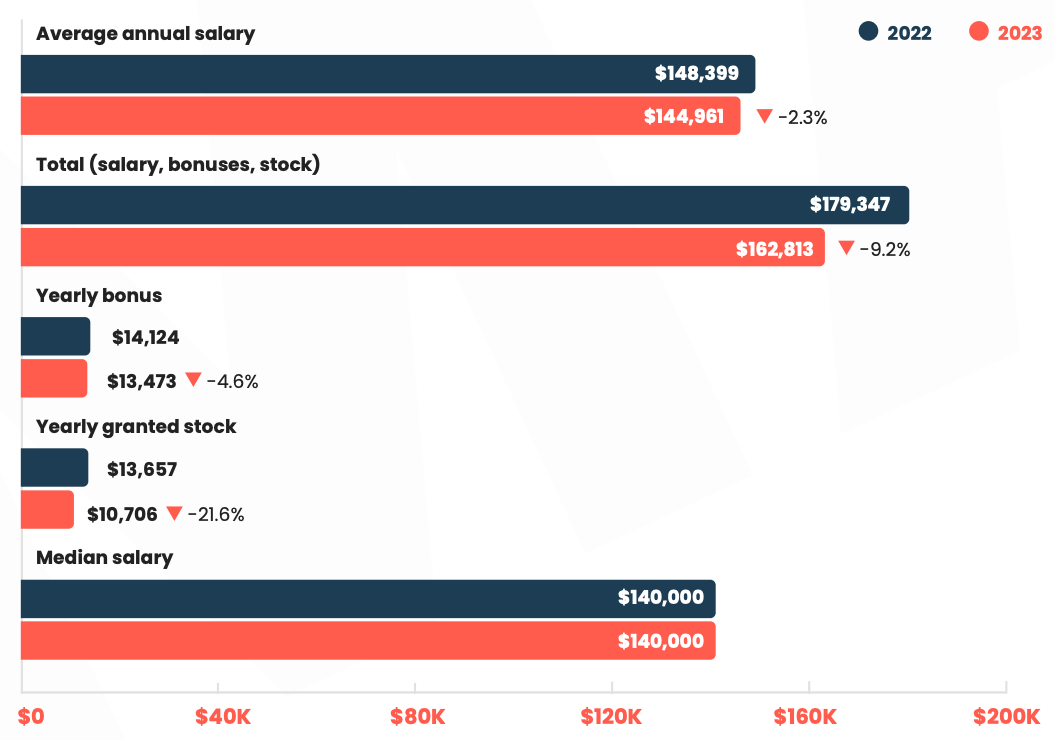
This ensemble sets the median salary at a robust $140,000. However, a year-on-year comparison uncovers a nuanced story – a general downtrend in average salary and total compensation.
Compared to 2022, PMMs’ total salary has dropped by 9%, the average salary before tax has fallen 2%, the yearly bonuses average has decreased by 5.5%, and the average annual stock granted has fallen by a notable 21.4%.
It’s crucial to consider the broader economic context, here, particularly the impact of inflation, which may influence the purchasing power of these salaries. Inflation has the potential to erode the real value of compensation, which affects the overall economic conditions for product marketers today.
Yet, the unwavering median salary indicates a stable appreciation for the PMM role.
Salary by region
The United States unsurprisingly remains the most lucrative country for product marketers, but which regions offer the highest base salaries?
Across the US, salaries vary dramatically by region. The Southwest, particularly Texas, emerges as a profitable haven for PMMs, boasting a median salary of $170,000. This figure is a testament to the region's thriving business ecosystem.
California, with its booming market, follows suit in the West, offering a median salary of $175,000. Although California provides PMMs with impressive pay, it has the third-highest cost of living in the US.
In stark contrast, the Midwest paints a different picture with a median income of $121,500, echoing the economic diversity within the country.
Product Marketing Salary Survey: US results 💸
Salary by state
While the regional breakdown tells part of the tale, which individual states contain the highest-earning product marketers?
Peering into the state-wise financial landscape, Texas shines with a whopping $40,000 jump in median salary — a figure that speaks volumes about its growing economic prowess as the Lone Star state now boasts a median salary 21% higher than the nationwide figure.
On the flip side, New York, despite its financial clout, sees a dip in median salary. Wisconsin and Virginia also enter the spotlight with significant median salary hikes – experiencing median salary increases of $29,975 and $20,000, respectively, compared to 2022 – illustrating the varied economic climates across states.
Base salary by city
City-wise, the narrative takes another turn. Boston now stands as the top-paying city for PMMs, with an average salary of $179,200 — a figure reflecting the city's burgeoning market demand for PMMs.
Austin isn't far behind, marking a staggering 31.4% surge in its average base pay, which now sits at $178,320, an increase of 31.4% from 2022 – an increase of $42,627!
New York has experienced the most tumultuous shift, seeing a drop from 2021 to 2022 of 20.5%, only to recover all the way back up (and more) in 2023 by a massive 38.1% increase, to $164,000.
However, the fluctuating fortunes of cities like Los Angeles, Philadelphia, and Atlanta, where average salaries have dipped – 9.9%; in Philadelphia with a drop from $140,111 to $115,860; and in Atlanta, with average salaries falling by 18.5% – reveal the complex tapestry of urban economic trends.
The cost of living
The regional, state, and city salary breakdown paints a complex picture of compensation for product marketers across the United States. However, the cost of living is a crucial factor that must be considered when evaluating these salaries.
The Southwest and California offer some of the highest median salaries, but these regions also have relatively high costs of living that impact real earnings. Texas and California rank 27th and 3rd for the cost of living nationally, with indexes of 92.5 and 137.6 respectively. So while the salaries appear lucrative, expenses in these areas are higher.
Conversely, while the Midwest has lower median salaries, the cost of living is also significantly lower. States like Kansas, Missouri, and Iowa have cost of living indexes between 87.5 and 89.2 – well below the national average. So PMMs in these regions may have lower nominal earnings but greater purchasing power.
This is similar at the city level: Boston and Austin offer high average base salaries, yet rank 9th and 15th for cost of living (indexes of 135.7 and 103.6). But cities like Philadelphia and Atlanta with dropping salaries also have more affordable lifestyles, ranking 43rd and 33rd in cost of living.
With this in mind, salaries only tell part of the total compensation story. Considering the cost of living context provides a more accurate view of real earning power and standards of living for product marketers across different parts of the United States.
Inclusivity and pay
Those who consider themselves minorities
It’s not just about location. Many factors come into play when decoding the salaries of PMMs. Personal perceptions, for one, are a key consideration to take into account.
For those who consider themselves a minority, in any capacity, our data reveals a compelling narrative: The statistics speak volumes – a noteworthy 1.1% increase in average salary before taxes, a robust 2.9% surge in total compensation, a commendable 2.1% rise in median salary, and an astonishing 109.9% uptick in yearly stock granted.
This stands in stark contrast to the previous year, where minority respondents lagged behind in every metric.
Gender
The gender pay gap regrettably remains a reality. For those who identify as female, this is a persistent struggle and a phenomenon that needs more consideration.
Peering into the gender pay dynamics of product marketing reveals some intriguing yet complex patterns. Yes, strides towards narrowing the gender pay gap are evident, but the journey is far from over. Male PMMs, on average, took home an average total compensation of $190,035, which was nearly 9.9% more than what their female counterparts earned.
This gap becomes more pronounced when we break down the components of this compensation. Men, on average, earn base salaries of about $158,581, outpacing women by approximately 10.9%. When it comes to bonuses, men again led the way, pocketing on average $6,173 more than women.
However, the plot thickens as we note a promising trend – this gap is slowly but surely closing. In a significant shift from 2022, men's base salaries are now just about 3% higher than those of women, bringing the overall compensation gap down to just over 6%.
Are there more male or female PMMs?
To begin with, it’s important to generate an accurate view of the gender split of common product marketing roles.
We found that females made up the majority of participants across most job title groupings. The notable exception was at the VP of Product Marketing level, where males are disproportionately represented at 53%.
Product Marketing Salary Survey: US results 💸
Where gender and seniority intersect
The interplay between gender and job titles in product marketing adds another layer to our story. It's a tale of contrasts and changing tides.
For instance, in roles such as PMM, Associate PMM, and Senior PMM, men typically reported higher average base salaries. But the narrative takes a twist when we climb the corporate ladder.
In higher roles like Directors of Product Marketing, women not only close the gap but often come out ahead, thanks in part to higher stock allocations.
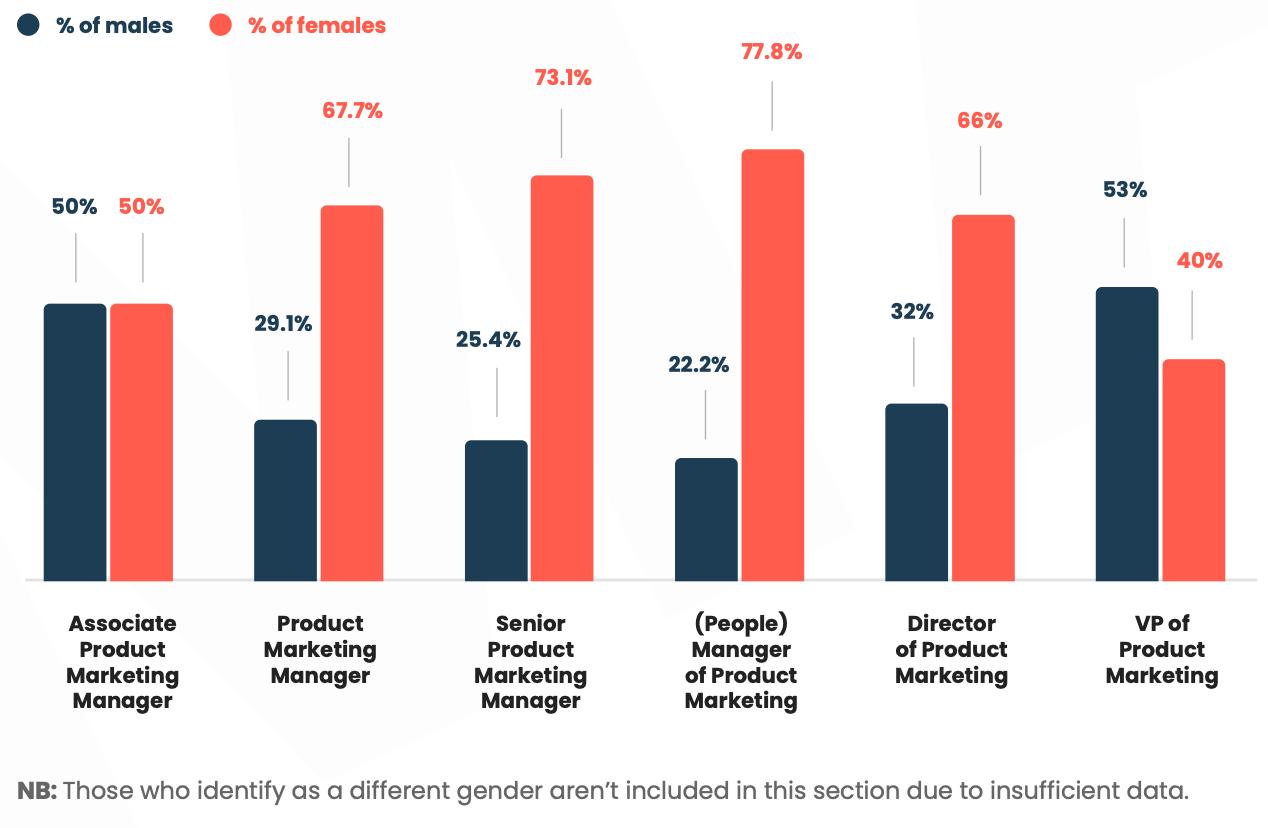
This scenario underscores a key point: The gender pay gap in product marketing is not a one-size-fits-all issue but rather one that varies across different job levels.
Are men and women earning more or less than last year?
In 2022, men’s average total compensation was $190,035, around 9.9% higher than for female respondents. Male base salaries were on average 10.9% higher ($158,581 vs. $142,985), and men received more in annual bonuses than women by an extraordinary $6,173.
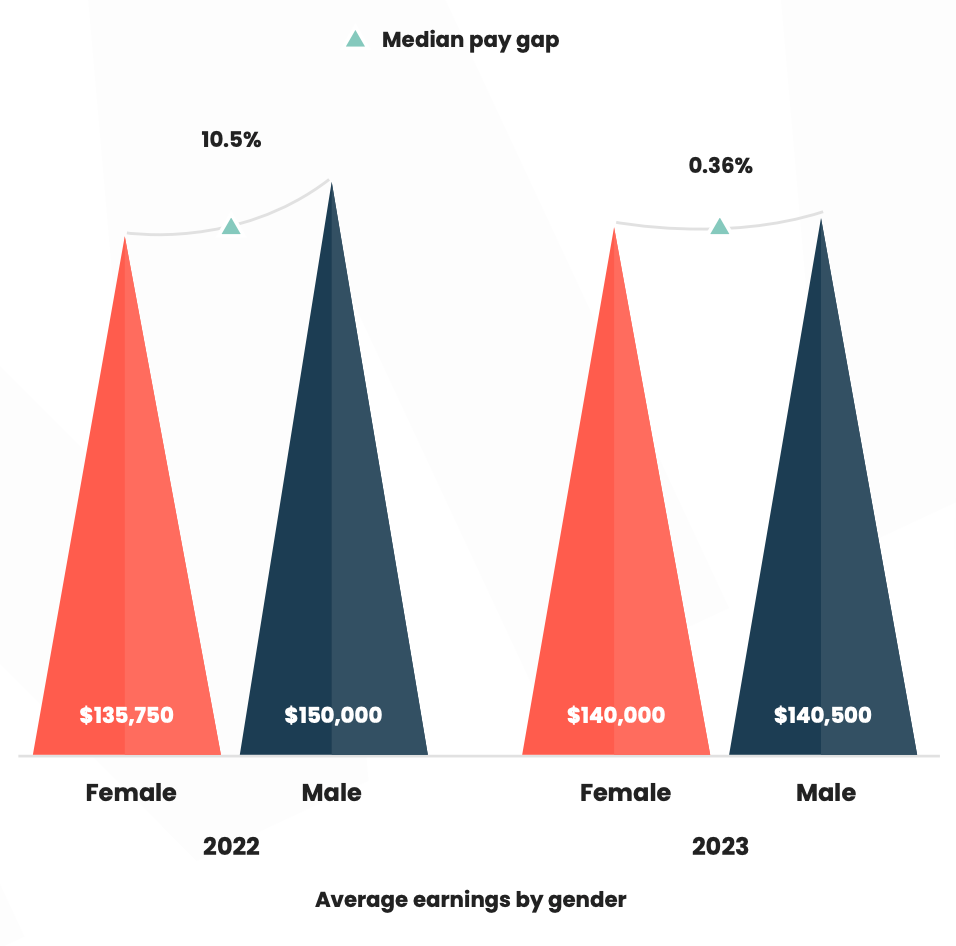
It seems that both male and female product marketers are earning less than in 2022 (with the exception of bonuses, which have risen slightly for women in 2023). With male base salaries falling 7% year-on-year, the overall gender pay gap has narrowed over the last 12 months.
Today, male base salaries are, on average, just 3% higher than those of females, revealing an overall gap in total compensation of just over 6%.
When turning to median annual salary, the gap between men and women is less pronounced, with male median pay sitting at $140,500 compared with $140,000 for women. In 2022, by contrast, we saw a much larger contrast in median pay, with $135,750 for female respondents, and $150,000 for males.
Encouragingly, this suggests that the median pay gap between men and women has fallen 96% in the last year.
Ethnic group
Aiming to understand the impact of ethnicity on earnings. Our analysis encompassed average annual and median salaries across each ethnic group, emphasizing year-on-year changes and comparing median salaries against the overall US product marketing median salary.
The results paint a vivid picture: South Asian PMMs lead the pack, boasting median salaries 24% higher than the national average. Following closely, those identifying as Multiracial – White and Asian product marketers – secure the second-highest earning position, with a notable 16% above the nationwide figure.
Despite a 26% surge in median earnings, Multiracial – White and Black product marketers, claim the lowest salaries relative to the national median.
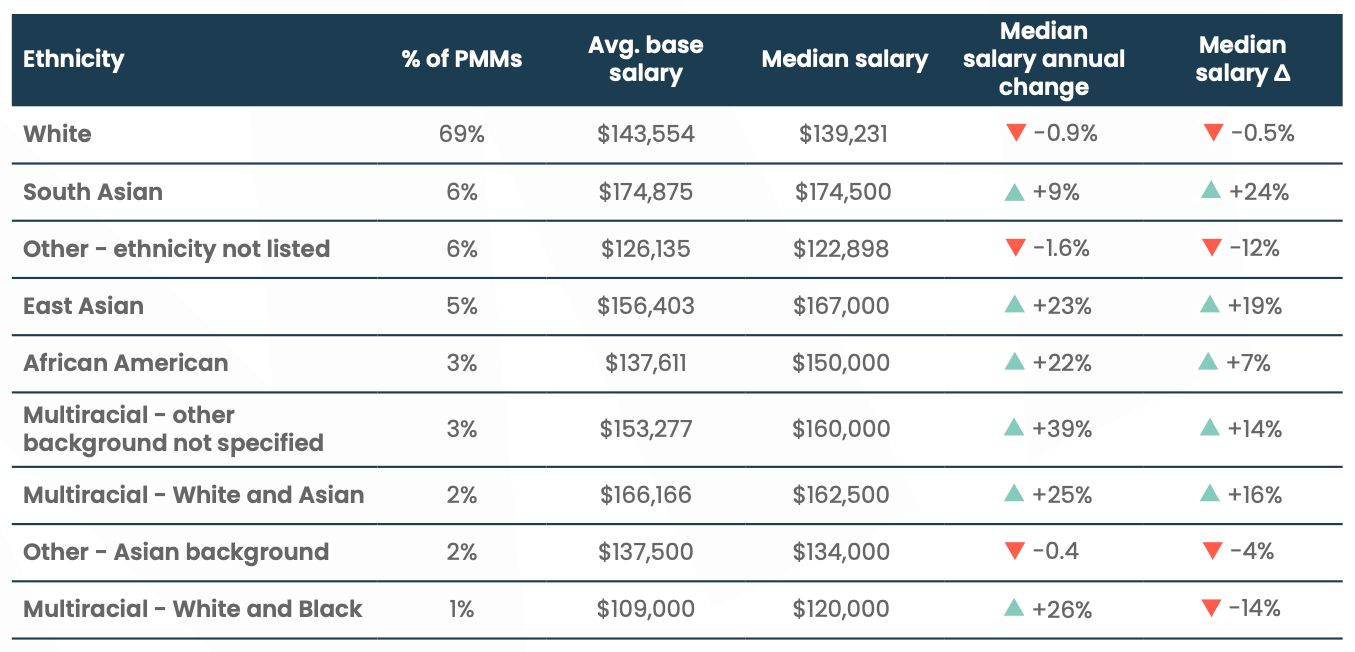
Disability (visible or invisible)
In the pursuit of shedding light on inclusivity in product marketing salaries, we turned our attention to disabilities, visible or invisible.
Analyzing the financial landscape, we uncovered a nuanced perspective. Respondents with a disability exhibited higher average base salary and median pay.
Intriguingly, those without a disability marginally surpassed the average total compensation by 0.6%, primarily due to the presence of higher annual bonuses. However, those opting not to disclose their disability status recorded the highest total compensation and median salary, albeit with a noticeable decrease in stock allocation compared to the other groups.
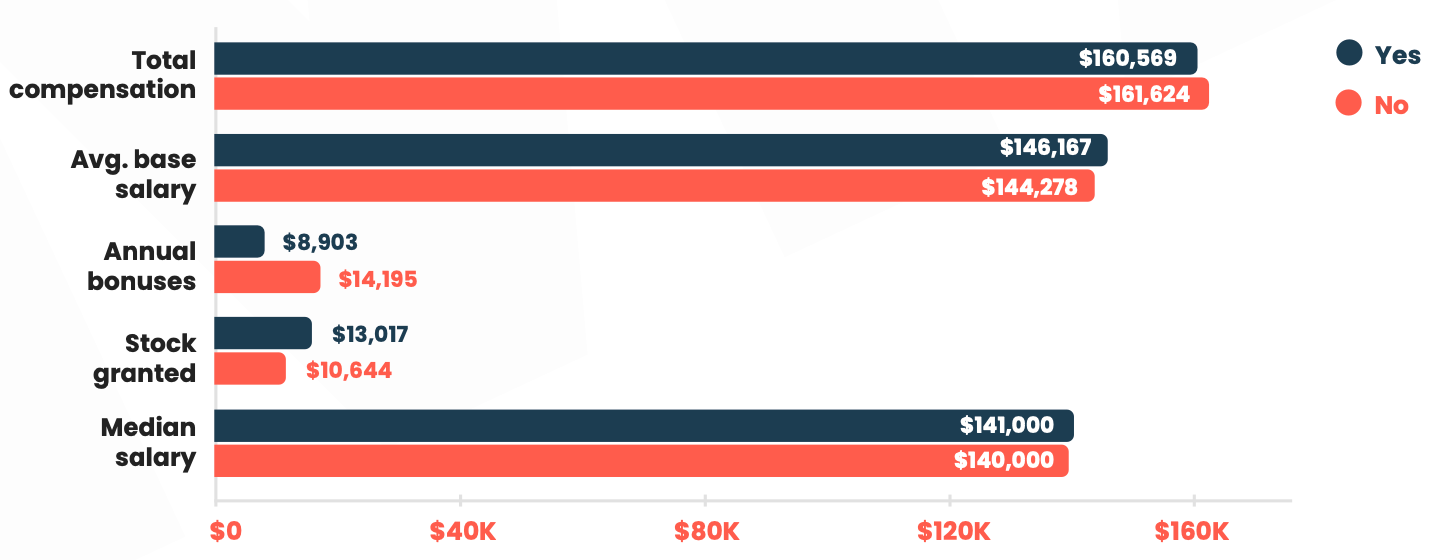
PMMs who have a disability, earn an average total compensation of $160,569, compared to those who don’t ($161624), earn lower bonuses ($8,903 compared to $14,195), but are granted more stock – $13,017 vs. $10,644.
This starkly contrasts with our 2022 findings, where average total compensation and median incomes were notably lower for disabled respondents.
Product Marketing Salary Survey: US results 💸
Job title and salary
In the world of product marketing, the title you hold does more than just define your role – it significantly influences your paycheck. Let’s start from the ground up.
Associate Product Marketing Managers, standing at the threshold of their careers, usually find their earnings on the lower end of the spectrum. But as you move up in your career, your financial rewards rise notably. For example, Senior PMMs, with an average of 6.36 years of experience, see a noticeable bump in their paychecks.
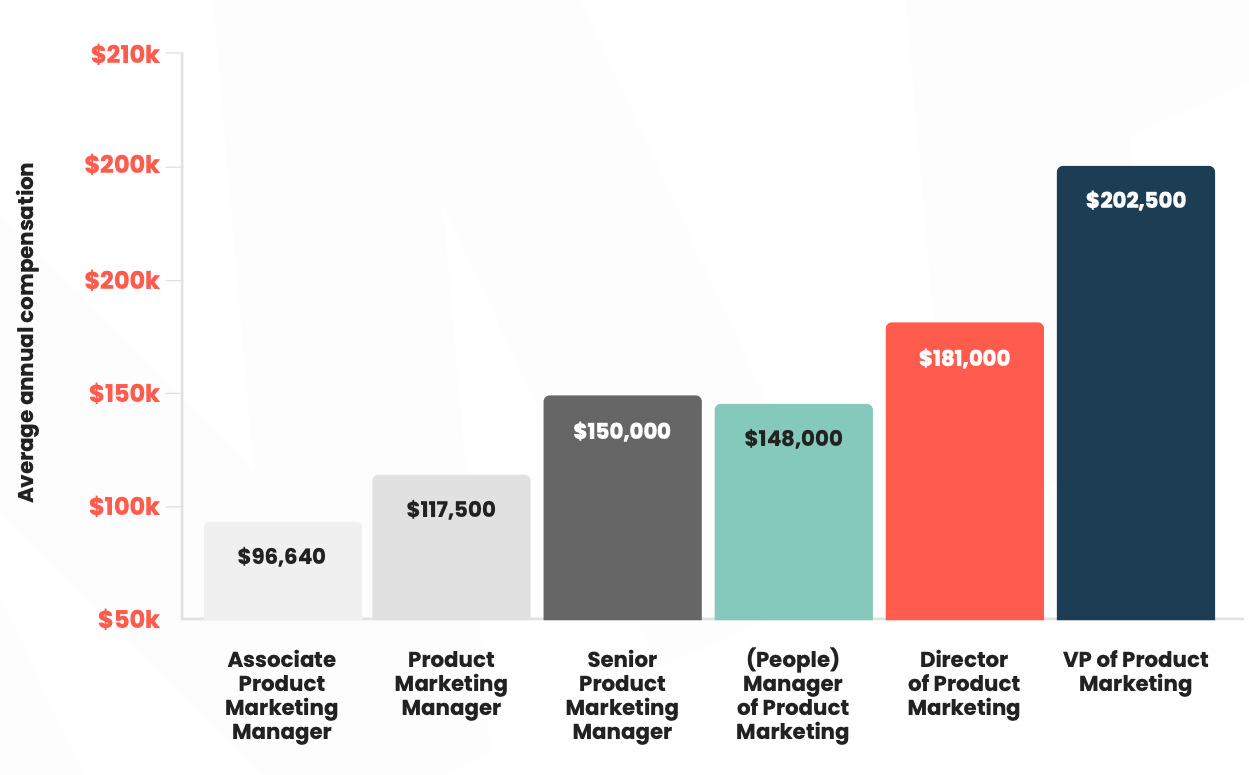
The real game-changer, however, comes as one ascends to the upper echelons – the Director and VP levels. Here, the salary leap can be eye-opening. Transitioning from a Senior PMM to a Director role can mean an average salary boost of 30.1%, and taking the step up to a VP position can surge earnings by an impressive 34.2%.
These figures not only speak to the value placed on experience and seniority in the industry but also highlight the fruitful potential that comes with climbing the product marketing ladder.
Industry
In addition to the wealth of factors we’ve discussed already, the salaries of PMMs vary significantly depending on the field you work in.
When it comes to industries, the leading protagonists are
- Computer software
- Information technology and services
- Financial services
- Marketing and advertising
- Computer and network security
Three of the five sectors take center stage with a bow to upward momentum. The computer software and information technology and services industries claim the spotlight, boasting year-on-year increases of 5.6% and 3.8%, respectively.
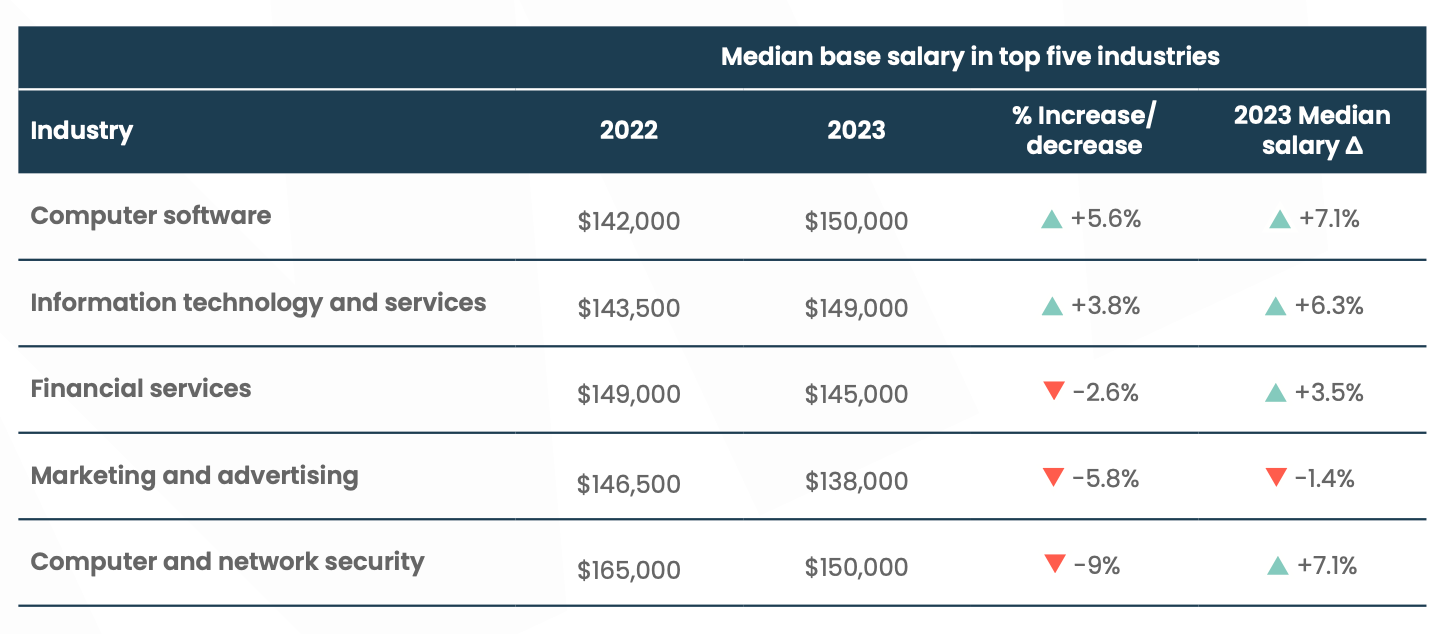
Getting into the numbers, the financial services sector earns a median base salary of $145,000, down 2.6% from 2022. A similar tale can be told for those in marketing and advertising – with a median salary of $138,000 (a drop of 5.8% from last year) and the computer network and security industry (150,000), whose base salary fell by 9% compared to 2022.
Customers served
Business-to-business (B2B) vs. business-to-consumer (B2C) – which is more financially advantageous?
The data speaks for itself: B2B product marketers command an impressive average base salary of $150,037 annually, overshadowing their B2C counterparts earning a more modest $116,833 per year. Those operating in both B2B and B2C spaces shine brightest, boasting the highest average annual salary of $155,578.
What does this look like when we explore the median?
B2B product marketers earn the most overall, with a median annual salary of $144,000, followed by those who work with both B2B and B2C ($137,000), and, coming in at the end, are B2C-focused PMMs, with $112,500.
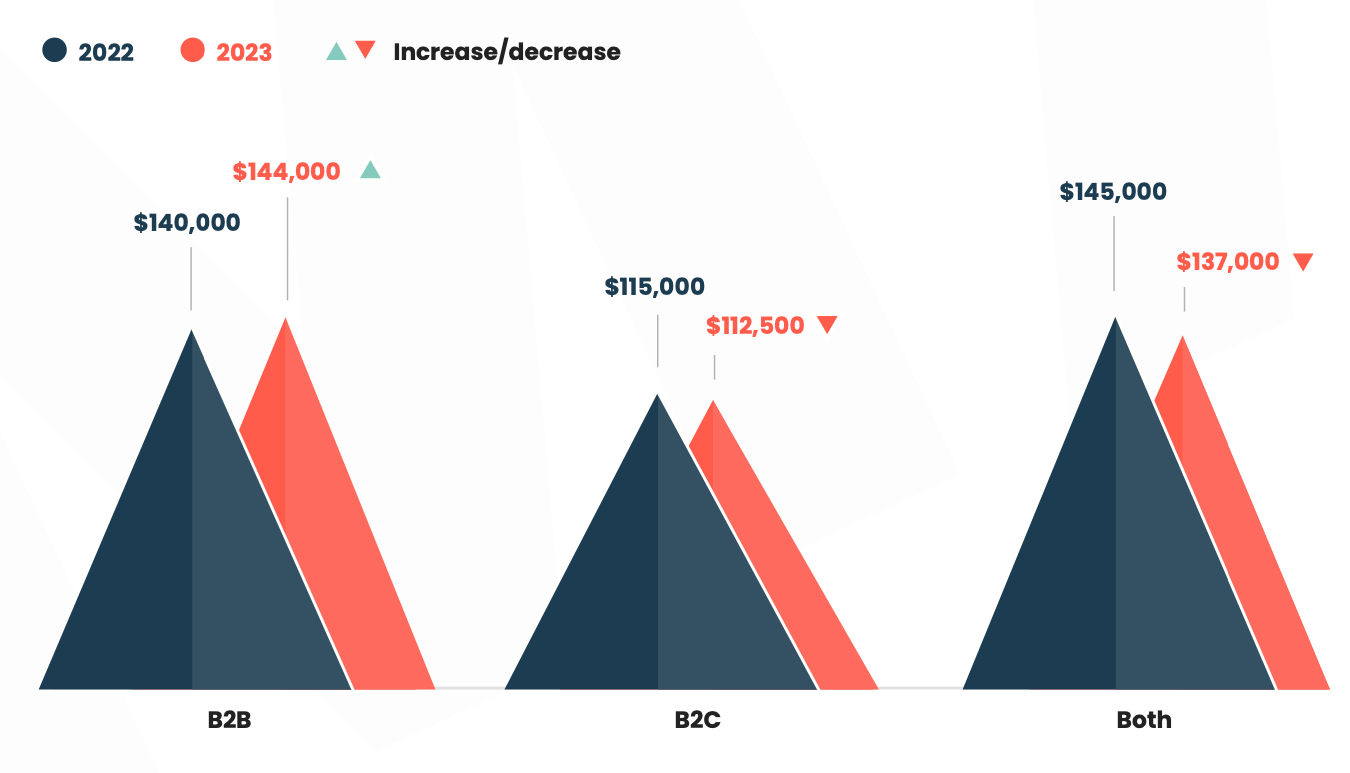
Personal experience and current role
To gain a richer understanding of how experience correlates with salary growth, we took a look at PMMs’ compensation compared to tenure in the field.
The results? As the years stack up, a rise in income appears. The narrative echoes a consistent upward trend, underscoring the notion that seasoned professionals leverage expanded skill sets and influential networks, resulting in heightened salaries.
However, a twist emerges: For those boasting over 20 years of experience, there's a 4% dip in median incomes, and those with 21+ years of experience encounter an 18% decline in total compensation, influenced by a substantial reduction in stock awards.
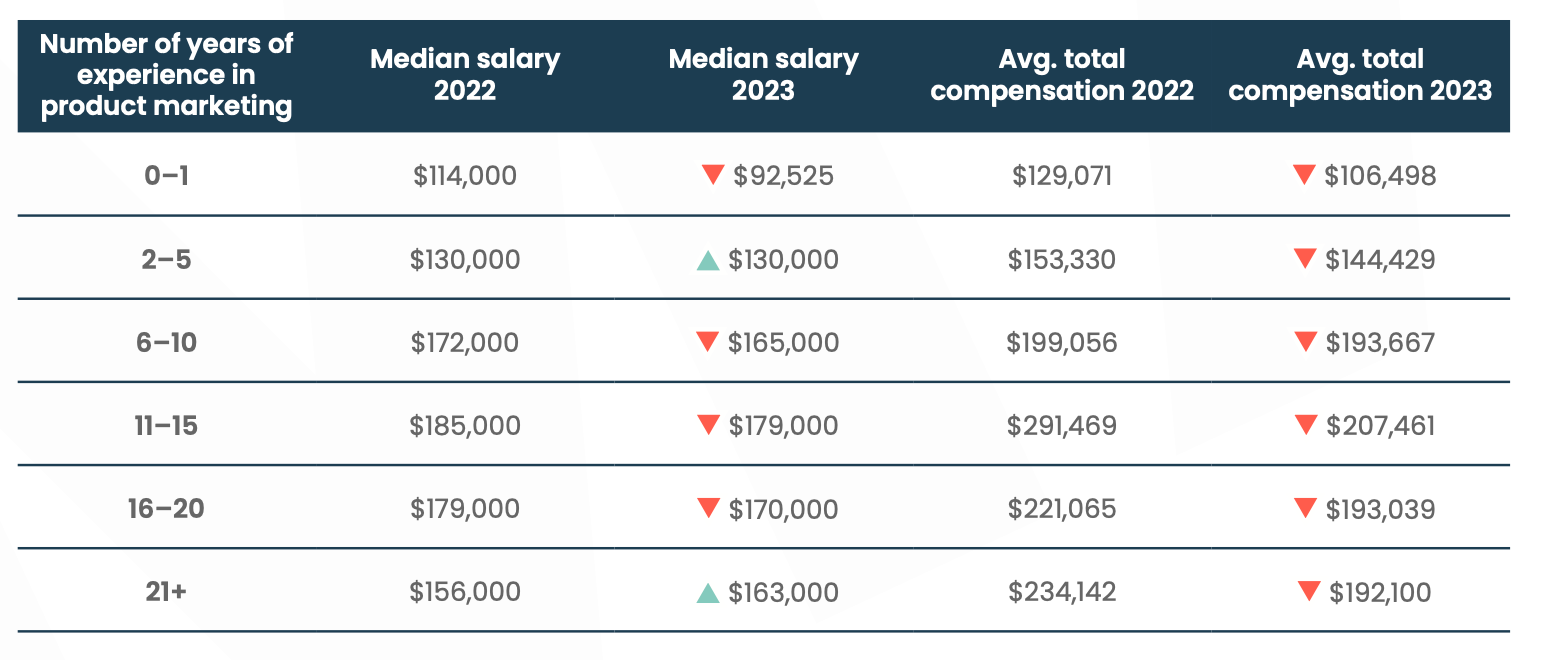
To certify, or not to certify?
As you know, here at PMA, we’re all about certifications. After all, knowledge is power, right?
If you were to assume that the more you know, the more you earn, you’d be correct. Our 2022 findings revealed that a mere 36.8% of Product Marketing Managers (PMMs) held the coveted product marketing certification, leaving 63.2% uncertified. Those without the formal seal were drawing an average base salary of $147,597, trailing their certified counterparts by $667.
Fast forward to 2023, and the plot thickens with an 8.6% surge in PMMs obtaining their product marketing certifications. The ongoing saga maintains a consistent theme – the certified cohort, fortified with formal validation, commands higher earnings.
With an average base salary of $145,748, they outshine their uncertified counterparts earning $142,634, unveiling a notable difference of $3,114.

Certifications require an investment but deliver concrete ROI in higher pay. They signal credibility and expand skills.
“Through my work as a mentor, I have learned that some of the early tasks of a new hire include positioning and messaging in both start-up and well-established orgs, it's a new concept to many, and I always endorse the PMA courses as the baseline to educate themselves. Furthermore, I hear from hiring managers that PMM certification is becoming a core requirement, and having it on your resume, will get you an interview at the very least.”
Amit Alagh, Senior Product Marketing Manager at LexisNexis
Education level
Beyond certifications, educational attainment also impacts earnings. PMMs with a master's degree earn a loftier median income of $152,500, significantly above the $135,250 median for those with only a bachelor's.
At the highest level, PMMs who hold a doctorate collect a median salary of $156,500. And those without any college education earn the least – though, still an impressive salary – at $130,000.
We can see that education pays off but for those unable or not wishing to go down that road, investing in professional certifications enables you to build up your bucks and grow expertise that allows you to command higher compensation.
Direct reports
Logically, PMMs managing others should earn more thanks to their increased duties. But how much more?
There’s harmony between leadership roles and compensation, as we see salaries grow alongside the number of direct reports product marketers have. PMMs managing 11+ employees earn a median salary of $220,000 – you read that right – that’s an impressive 57% above the industry median.
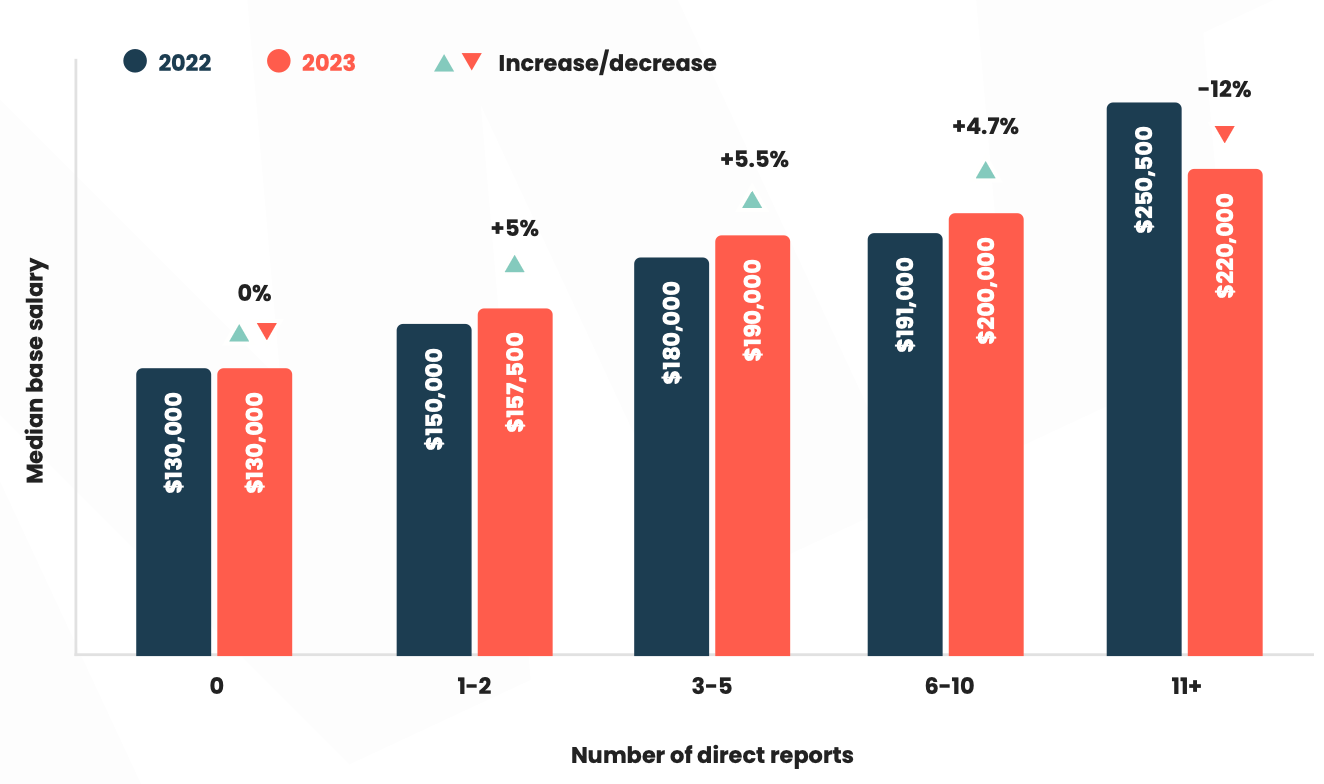
Number of products managed
As product marketers, it’s only natural to be drawn to the product side of things. So, while the number of people you manage clearly boosts earning potential, can the same be said for products?
Unlike educational attainment and the number of direct reports, there’s no direct correlation between average incomes and the number of products managed. In fact, PMMs managing one product gain more in total compensation, on average, than product marketers supporting 10.
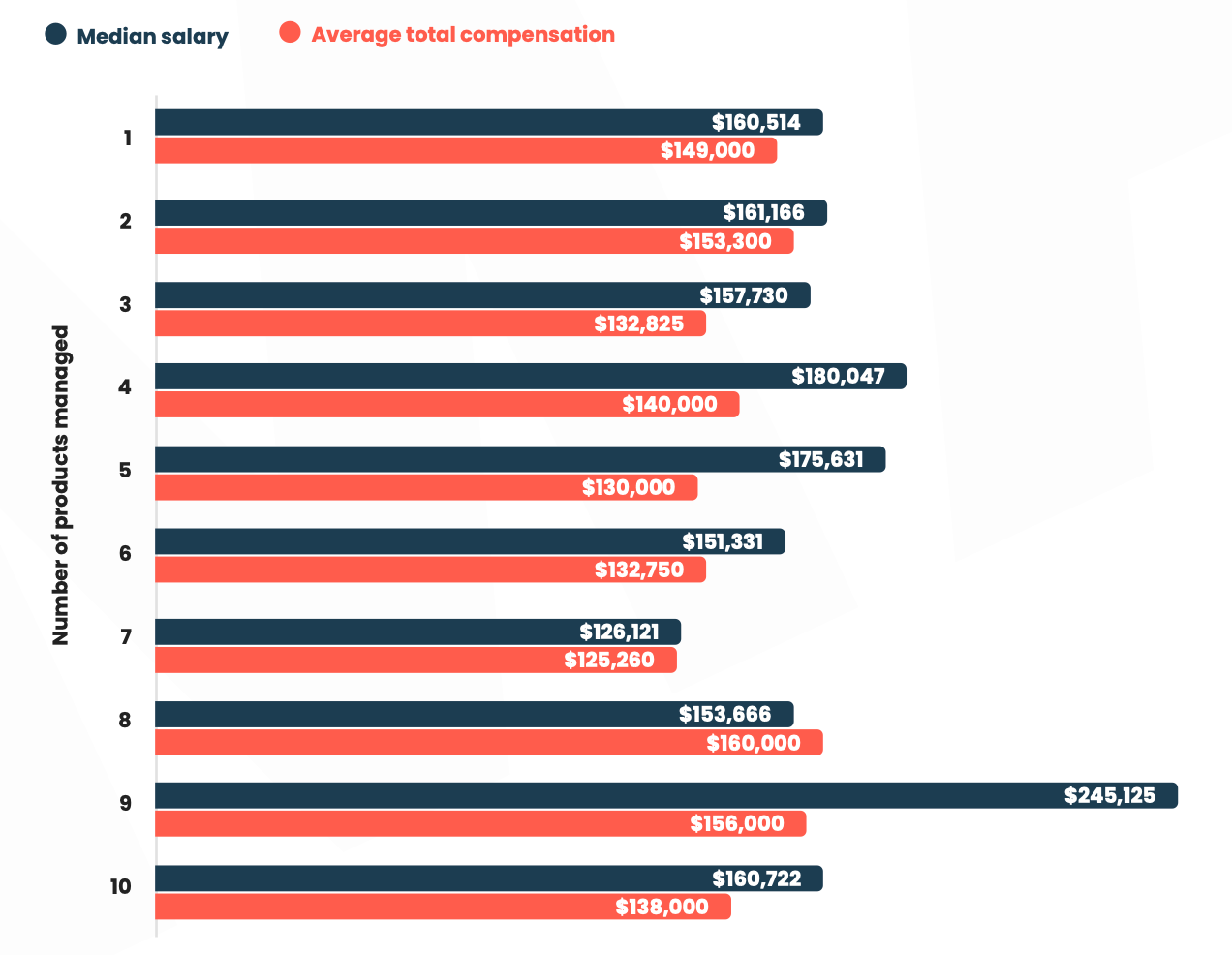
Office-based versus remote
In 2022, 65.9% of PMMs reported working remotely. Despite efforts to encourage a return to the office, the proportion of respondents in remote roles has only slightly fallen to 62.8% in 2023.
A subtle shift is observed in the proportion of fully office-based PMMs, rising from 2.5% to 2.7%. However, the most significant leap lies in the hybrid working category, with a third of product marketers now navigating the delicate balance between home and the office.
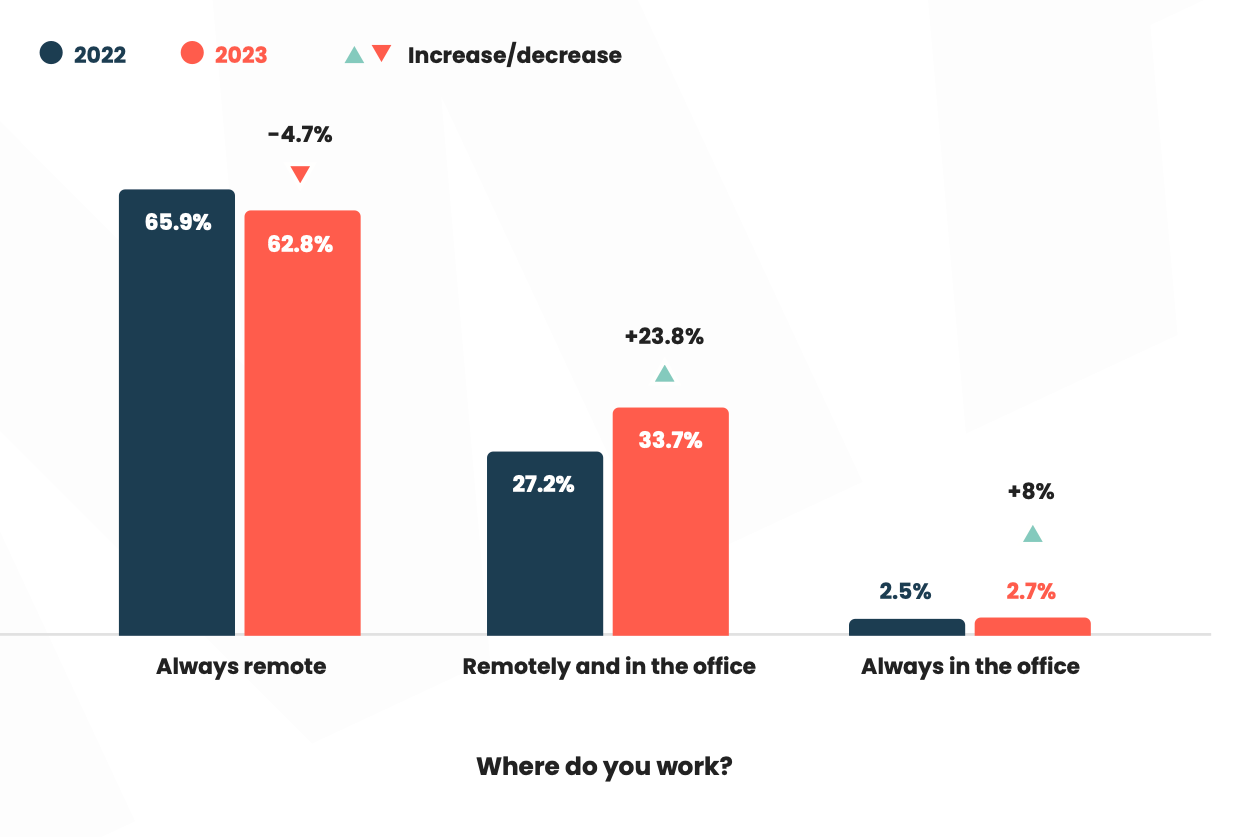
What does this mean for PMMs’ salaries? The data unveils that fully remote workers enjoy the highest average salaries and total compensation packages at $147,301 and $164,002, respectively.
Following closely, PMMs with a hybrid work arrangement report average earnings and compensation of $139,971 and $163,111, respectively. In contrast, office-based product marketers record the lowest average salaries and compensation packages, with median salaries trailing 18% below the nationwide product marketing income.
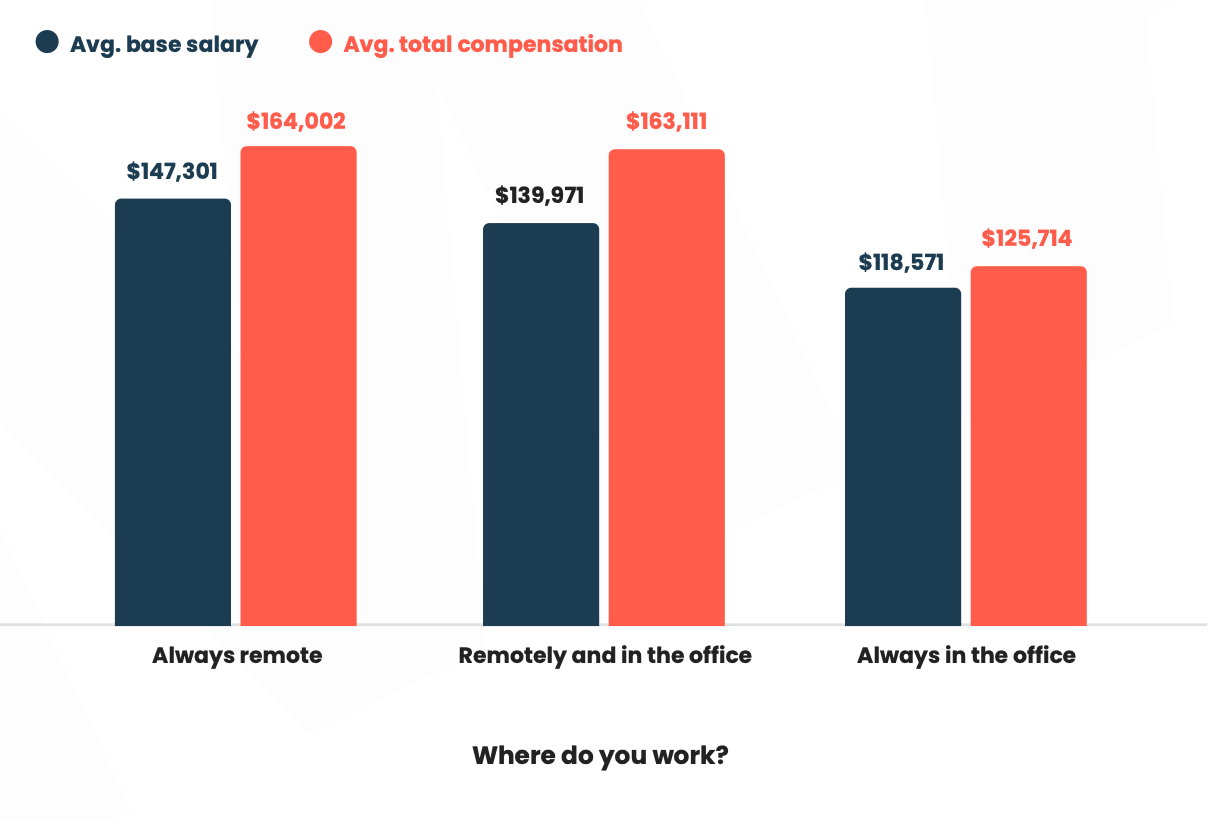
What does this teach us? With remote work preferred by most PMMs, organizations may need to adjust compensation to remain competitive in recruiting and retention.
Final Reflections: Gauging the current financial worth of a PMM
The role of a product marketer in the United States embodies the evolving essence of marketing and strategic business roles. The compensation trends we observe are more than mere numbers; they symbolize the market's acknowledgment of PMMs’ strategic significance.
While strides are being made in narrowing the gender pay gap and addressing regional disparities, these efforts highlight the industry's commitment to equitable and inclusive practices.
As we navigate through our careers, the true essence of a PMM's worth lies not only in the paycheck but in the indispensable role of shaping market trends and driving business success in a dynamic global landscape.
Keen to discover more about product marketing salaries in the US?
Read our full 2023 Product Marketing Salary Survey report which delves further into PMMs’ pay and covers factors like:
🌱 Company growth size
🤝 Support from the C-suite
💫 Company culture
⚖️ Salary satisfaction
And much more!
Discover how your pay truly compares to similar roles in your metro area or companies within your niche. Gain perspective on how factors like skills, experience level, and education impact earning potential coast to coast.
From California tech giants to East Coast startups, this report gives you the US-focused salary context you need to command your value.


















 Follow us on LinkedIn
Follow us on LinkedIn



.svg?v=85af970283)